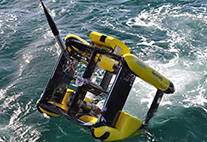Ecosystem North Sea: Fisheries research produces valuable data in record time
3 September 2014, by Franziska Neigenfind

Photo: UHH/CEN/A. Eckhardt
Small, but plentiful: Minuscule water organisms–commonly known as plankton–are drifting with the rhythm of ocean currents. These organisms can tell oceanographers a lot
Small, but plentiful: Minuscule water organisms–commonly known as plankton–are drifting with the rhythm of ocean currents. These organisms can tell oceanographers a lot about the North Sea’s ecosystem. On their latest expedition, fisheries scientists from the Center for Earth System Research and Sustainability (CEN) obtained myriads of previously unsuspected information on plankton.
In the area between the German North Sea island Helogoland and the Scottish coastal town Stonehaven a CEN research team investigated plankton incidences. Parallel to that, the scientists conducted various measurement series, focusing on oceanographical and chemical seawater constants such as temperature, salinity and oxygen levels, density, lighting conditions, and active photosynthetic substances, for instance chlorophyll. An immense amount of data was recorded within seconds. “Never before has this much information about the North Sea been collected so quickly,“ emphasizes Prof. Marc Hufnagl from the CEN. “The evaluation is in full flood.“
Initial analyses show: Major quantities of plankton are floating in sections of the sea where heated bodies of water mingle with cooler layers—inshore as well as in certain depths of the sea. North Sea fish, for instance herring or sand eel, depend on plankton as a food resource. Thus, the expedition team aims to also provide data about North Sea fish stocks in the future.
Prior measuring methods did not permit detailed studies of dense planktonic clouds. Therefore, the research vessel “Heincke” employed the Triaxus, a towed vehicle equipped with state-of-the-art measuring technology. The vehicular device, which employs numerous sensors, appears slightly futuristic as it glides through the water towed by the “Heincke.” “Our Triaxus is probably the best equipped one in the world,” says Tim Dudeck, a doctoral student at the Cluster of Excellence for climate research CliSAP. “We recently fitted it with an additional plankton video recorder.” The high performance recorder makes microscopic exposures of plankton particles, thus helping scientists analyze the distribution of species, their size spectrums, and population densities. Parallel to that, a built-in sonar (ADCP, an acoustic Doppler current profiler), captures the current velocity by means of sound.
The expedition, headed by CEN-professor Christian Möllmann, formed part of the project “North Sea—Observation and Assessment of Habitats” (NOAH), which is being coordinated by the Institute for Coastal Research of the Helmholtz-Zentrum Geesthacht (Centre for Materials and Coastal Research). Prof. Kay-Christian Emeis is the project leader of NOAH.
